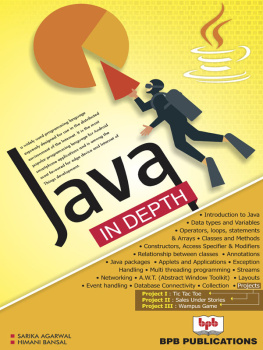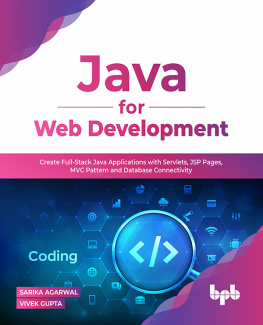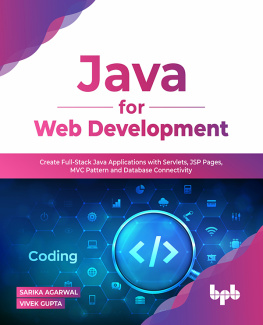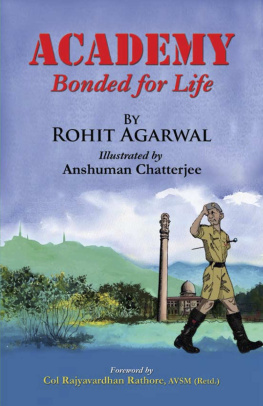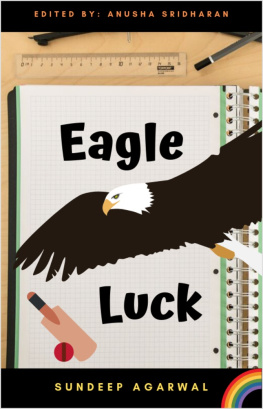Sarika Agarwal - Java in Depth
Here you can read online Sarika Agarwal - Java in Depth full text of the book (entire story) in english for free. Download pdf and epub, get meaning, cover and reviews about this ebook. year: 2023, publisher: BPB Publications, genre: Computer. Description of the work, (preface) as well as reviews are available. Best literature library LitArk.com created for fans of good reading and offers a wide selection of genres:
Romance novel
Science fiction
Adventure
Detective
Science
History
Home and family
Prose
Art
Politics
Computer
Non-fiction
Religion
Business
Children
Humor
Choose a favorite category and find really read worthwhile books. Enjoy immersion in the world of imagination, feel the emotions of the characters or learn something new for yourself, make an fascinating discovery.
- Book:Java in Depth
- Author:
- Publisher:BPB Publications
- Genre:
- Year:2023
- Rating:5 / 5
- Favourites:Add to favourites
- Your mark:
- 100
- 1
- 2
- 3
- 4
- 5
Java in Depth: summary, description and annotation
We offer to read an annotation, description, summary or preface (depends on what the author of the book "Java in Depth" wrote himself). If you haven't found the necessary information about the book — write in the comments, we will try to find it.
Java in Depth — read online for free the complete book (whole text) full work
Below is the text of the book, divided by pages. System saving the place of the last page read, allows you to conveniently read the book "Java in Depth" online for free, without having to search again every time where you left off. Put a bookmark, and you can go to the page where you finished reading at any time.
Font size:
Interval:
Bookmark:


www.bpbonline.com
FIRST EDITION 2018
Copyright BPB Publication, INDIA
ISBN: 978-93-8655-157-3
All Rights Reserved. No part of this publication can be stored in a retrieval system or reproduced in any form or by any means without the prior written permission of the publishers.
LIMITS OF LIABILITY AND DISCLAIMER OF WARRANTY
The Author and Publisher of this book have tried their best to ensure that the programmes, procedures and functions described in the book are correct. However, the author and the publishers make no warranty of any kind, expressed or implied, with regard to these programmes or the documentation contained in the book. The author and publisher shall not be liable in any event of any damages, incidental or consequential, in connection with, or arising out of the furnishing, performance or use of these programmes, procedures and functions. Product name mentioned are used for identification purposes only and may be trademarks of their respective companies.
All trademarks referred to in the book are acknowledged as properties of their respective owners.
Distributors:
BPB PUBLICATIONS
20, Ansari Road, Darya Ganj
New Delhi-110002
Ph: 23254990/23254991
COMPUTER BOOK CENTRE
12, Shrungar Shopping Centre,
M.G.Road, Bengaluru-560001
Ph: 25587923/25584641
MICRO MEDIA
Shop No. 5, Mahendra Chambers,
150 DN Rd. Next to Capital Cinema,
V.T. (C.S.T.) Station, MUMBAI-400 001
Ph: 22078296/22078297
DECCAN AGENCIES
4-3-329, Bank Street,
Hyderabad-500195
Ph: 24756967/24756400
BPB BOOK CENTRE
376 Old Lajpat Rai Market,
Delhi-110006
Ph: 23861747
Published by Manish Jain for BPB Publications, 20, Ansari Road, Darya Ganj, New Delhi-110002 and Printed by Repro India Pvt Ltd, Mumbai
The authors are confident that the present work will come as a relief to the students wishing to go through a comprehensive material for understanding Java concepts in layman's language, offering a variety of analogical understanding and code snippets. This book covers all the topics/content/syllabus prescribed at various levels in universities.
This book promises to be a very good starting point for beginners and an asset to advance users too.
This book is written as per the syllabus of majorly all the universities and covers topics both at under-graduate and graduate level. Difficult concepts of Core Java are given in an easy way, so that the students are able to understand them in an efficient manner.
It is said To err is human, to forgive is divine. In this light, we wish that the shortcomings of the book will be forgiven. At the same, the authors are open to any kind of constructive criticisms and suggestions for further improvement. All intelligent suggestions are welcome and the authors will try to do their best to incorporate such invaluable suggestions in the subsequent editions of this book.
Sarika Agarwal
Himani Bansal
Although the Java programming language is usually associated with the World Wide Web, it's origin predates the web. Java began life as the programming language OaK.
OaK was developed by the members of the Green project, which included Patrick Naughton, Mike Sheridan and James Gosling a group formed in 1991 to create Product for the smart electronics market. The team decided that the existing programming languages were not well suited for use in consumer electronics. The chief programmer of Sun Microsystems, James Gosling, was given the task of creating the Software for controlling consumer electronic devices. The team wanted a fundamentally new way of computing, based on the power of networks and wanted the same, software to run on different kinds of computers, consumer gadgets and other devices. Patenting issues gave a new name to Oak-Java. During that period, Mosaic, the first graphical browser was released. Non programmers started accessing the World Wide Web and Web grew dramatically. People with different types of machines and operating Systems started accessing the application available on the web. Members of the OaK team realized that Java would provide the required cross-platform independence that is, independence from the hardware, the network, and the operating System. Very soon, Java became an integral part of the web.
Java Software works just about everywhere, from the smallest devices to Super computers. Java technology components don't depend on the kind of computer, telephone, or operating System they run on. They work on any kind of compatible devices that Supports the Java platform.
The Fist Java Beta (jdk Beta) version released in 1995 and First Version (jdk 1.0) released in 1996. Java is enhancing its functionality and latest version of java is jdk 1.8 released in 2014.
No discussion of Java can be done without the keywords. Although the fundamental forces that are necessary for Java are portability & Security; other factors also play an important role in moulding the final form of the language. The features of Java or Buzzword are as follows:
- Simple
Java is a simple language that can be easily learn, even if you have just started programming. Best of all, if you are an experienced C++ programmer, moving to Java will require very little effort. Because Java inherits the C, C++ syntax and many of the object-oriented features of C++. Moreover unlike C++ in which the programmer handles memory manipulation, Java handles the required memory manipulation, and prevents errors that arise due to in proper memory usage. Java also removes complexity like operator overloading and virtual functions.
- Object-oriented
Java defines data as objects with methods that support Inheritance. It is purely object-oriented and provides abstraction, encapsulation, and polymorphism. Even the most basic program has a class. Any code that you write in Java is inside a class.
- Distributed
Java is tuned to the Web. Java programs can access data across the webs as easily as they access data from local system because Java handles TCP/IP protocols. It means accessing a resource using a URL is not much different from accessing a file. You can build distributed application in Java that uses resources from any other networked computer.
- Interpreted
Java is both interpreted and compiled. The code is compiled to a byte code, which is binary and platform independent. When the program has to be executed, the code is fetched into the memory and interpreted on the user's machine. When you compile a piece of code, all the errors are listed together. You can execute a program only when all the errors have been rectified. An interpreter on the other hand, verifies the code and executes it line by line.
- Portable
Byte code is the result of compiling a Java program. You can execute this code on any platform. In other words due to the byte code compilation process and interpretation by a browser, Java program can be executed on a Variety of hardware, and operating System. The Java compiler is written in Java and the runtime environment, i.e. the Java interpreter is written in C. The Java interpreter can execute Java code directly on any machine on which a Java interpreter has been installed. Due to byte code, a Java program can run on any machine that has a Java interpreter. The byte code supports connection to multiple databases thus making Java code portable.
Font size:
Interval:
Bookmark:
Similar books «Java in Depth»
Look at similar books to Java in Depth. We have selected literature similar in name and meaning in the hope of providing readers with more options to find new, interesting, not yet read works.
Discussion, reviews of the book Java in Depth and just readers' own opinions. Leave your comments, write what you think about the work, its meaning or the main characters. Specify what exactly you liked and what you didn't like, and why you think so.

